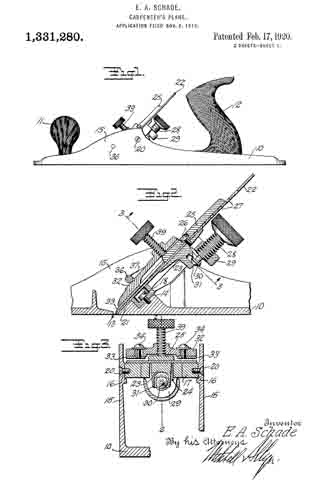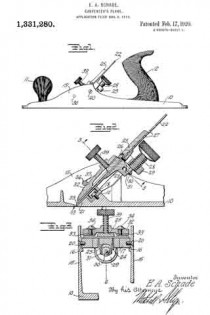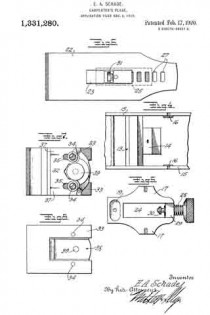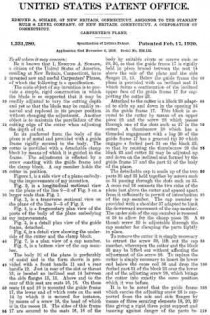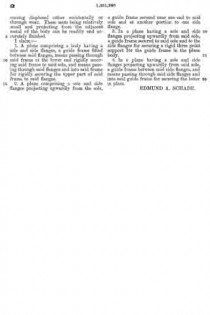No. 1,361,433 – Carpenter’s Plane (Ralph Allen) (1920)

UNITED STATES PATENT OFFICE.
_________________
RALPH ALLEN, OF SHELTON, CONNECTICUT, ASSIGNOR TO THE
ACME TOOL & MACHINE CO., OF DERBY, CONNECTICUT, A CORPORATION.
CARPENTER’S PLANE.
_________________
1,361,433. Specification of Letters Patent. Patented Dec. 7, 1920.
Application filed February 3, 1920. Serial No. 355,938.
_________________
To all whom it may concern:
Be it known that I, RALPH ALLEN, a citizen of the United States, residing at Shelton, in the county of Fairfield and State of Connecticut, have invented a new and useful Improvement in Carpenters’ Planes; and I do hereby declare the following, when taken in connection with the accompanying drawings and the characters of reference marked thereon, to be a full, clear, and exact description of the same, and which said drawings constitute part of this application, and represent, in —
Figure 1. A view in side elevation showing my improved sheet-metal cutter-cap clamp as applied to a plane which is broken away except one of the upstanding side-flanges of its body.
Fig. 2. A detached plan view of the cutter-cap clamp shown as mounting the clamping-lever.
Fig. 3. A view thereof in central longitudinal section, the lever being shown in elevation.
Fig. 4. A view of the clamp in transverse section on the line 4–4 of Fig. 2.
Fig. 5. A broken plan view of the outer end of the clamp.
Fig. 6. An edge view thereof.
Fig. 7. A detached plan view of the clamping-lever.
Fig. 8. A view thereof in end elevation.
My invention relates to an improvement in carpenters’ planes and more particularly to cutter-cap clamps therefor, the object being to produce a simple, durable, easily operated clamp of greater resiliency and therefore more positive clamping action than the cast-metal clamps now generally employed.
With these ends in view, my invention consists in a one-piece sheet-metal cutter-cap clamp adapted at its rear end to mount a clamping-lever and furnished upon its under face with a spring engaging with the said lever to hold the same in place.
My invention further consists in certain details of construction and combinations of parts as will be hereinafter described and pointed out in the claims.
In carrying out my invention, as herein shown, I produce from a single piece of sheet-metal, such as steel, a cutter-cap clamp 5 having at its forward end a straight gripping-edge 6, and having its side edges turned downward throughout its and having its rear end rounded at the corners and turned downward to form a curved bearing-flange 8. The rear end of the clamp is formed with a longitudinal slot 9 centrally intersecting the curved flange 8 and provided for the reception of the shank 10 of the clamping-lever 11 which is furnished with relatively large trunnions 12 offsetting from opposite faces of its shank and with an operating-cam 13 forming an extension thereof. The respective trunnions 12 aforesaid have bearing upon the inner faces of the curved end-flange 8, at points on opposite sides of the slot 9 as shown in Figs. 2 and 3, and are held against the said flange by means of a spring 14 engaging with the cam 13 of the lever and welded or otherwise fastened to the lower face of the clamp, as at 15, at a point directly to the rear of the reduced rear end of the key-hole slot 16 formed in the clamp for the reception of the screw 17 by means of which the clamp is secured to the inclined cutter-support 18 located between the upstanding flanges or cheeks 19 of the plane body or frame, which may be of any approved construction and is not shown. The cutter 20 rests upon the said support 18. A cutter-cap 21 is placed upon the upper face of the cutter and as so placed is directly interposed between the cutter and my improved cutter-cap clamp. The said spring 14 is accommodated within the chamber 22 formed within the clamp by the downwardly turned side-flanges 7 and the downwardly turned rear end flange 8 thereof.
In the use of my invention, after the cutter has been properly adjusted as to its cutting edge, the clamping-lever is forced downward from its open position, in which it is shown by broken lines in Fig. 3 into its closed position, in which it is shown by full lines in the said figure, as well as in Fig. 1. As the lever is crowded downward into its closed position, its cam 13 acts upon the upper face of the spring 14 and crowds the same down upon the upper face of the cutter with which the cam itself makes no direct contact. As the clamping-lever is crowded into its closed position, as described, the cutter clamp yields throughout its length and to a greater extent than any of the cast-iron clamps heretofore used, the straight gripping-edge 6 of the clamp taking firm hold of the forward end of the cutter, and the spring 14 taking firm hold of the rear end thereof whereby the cutter is positively held against endwise movement.
By providing the clamping-lever with integral trunnions of relatively large diameter and holding the said trunnions in their bearings by means of a spring, I simplify and strengthen the construction over the pivot-pin construction of the prior art, making the plane more durable and also making it easier to operate, as the larger the trunnions, the easier it is to operate the clamping-lever.
I claim:
As a new article of manufacture, a one-piece, sheet-metal, cutter-cap clamp for a carpenter’s plane, the said clamp having its side edges turned downward throughout its length to form side-flanges, and having its rear end turned downward to form a bearing-flange, and provided with a longitudinal slot centrally intersecting the said bearing-flange, whereby the clamp is adapted to mount a clamping-lever, and the said clamp having a lever-retaining spring secured to its inner face and located within the chamber formed by the said downwardly turned side-flanges and downwardly turned rear end bearing-flange.
In testimony whereof, I have signed this specification in the presence of two subscribing witnesses.
RALPH ALLEN.
Witnesses:
W. C. J. MACALLER,
WILLIAM F. HEALEY.















